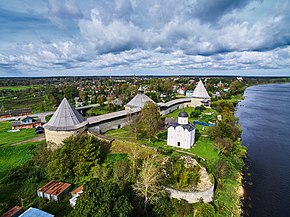
If you try and search the word “ladoga”, several results will come up. The suggestions will show villages, water bodies, to the names of newspaper and confectionery company. Ladoga Lake is usually the one people look for, as it is one of the most popular tourist attractions in Russia. However, the one we will discuss here is a village placed in the Leningrad Region and known as the ancient capital of Northern Russia. From Ladoga alone, we can learn a lot about the Russian civilization.
The meaning of Ladoga
The name of the city was derived from the name of Lake Ladoga, or from the name of the Ladoga River. In the opinion of linguist E.A. Khelimsky, the name of the lake is primary. The historian T.N. Jackson writes that “to date, it can be considered almost proven that the name of the river first appeared, then the city, and only then the lake.” Therefore, she considers from the name of the river came the name of the city of Aldegia, and it was already borrowed by the Slavic population and transformed using the metathesis into other Russian: Ladoga. The Scandinavian medium between the Finnish and Old Russian words is confirmed, according to T.N. Jackson, and archaeological material: the Scandinavians appeared on Ladoga in the early 750s, that is, a couple of decades earlier than the Slavs.
The history of the village
The first settlement consisted of several pillar structures, which have analogues in Northern Europe, and was set 2 km south of the Lyubshan fortress, founded by representatives of the original Slavic culture of Central European origin. The area of the original Staroladozhsky settlement did not exceed 2–4 ha. It was then that the interests of the ancient Slavs, the ancient Germans and the local Finno-Balts crossed in the region. During the excavations of the 18th century, a whole industrial complex was discovered during excavations. During this period, the settlement is already trading with local tribes.
In the 760s, the Ladoga settlement was destroyed by representatives of Early Slavic culture from the South-West: the Dnieper Left Bank or Dniester, the Podunavye, the upper reaches of the Dnieper, the Western Dvina or the Volga and built up with houses of log construction. There is a lack of continuity between the first inhabitants of Ladoga and the subsequent population, who had other cultural traditions. In Ladoga, as in other places in the north-west of Russia (Izborsk , Kamno , Ryuge , Pskov) in the 18th to 19th centuries foundry molds made of limestone became widespread.
In the 19th century, the village administratively belonged to the Mikhailovsky volost of the 1st camp of the Novoladozh district of St. Petersburg province, at the beginning of the 20th century – of the 2nd camp. From 1917 to 1919, the village of Staraya Ladoga was part of the Staroladozhsky village council of the Mikhailovsky volost of Novoladozhsky district.
According to 1933 data, the village of Staraya Ladoga was the administrative center of the Staroladozhsky village council of the Volkhov district, which included 17 settlements with a total population of 2312 people. According to 1936 data, the Staroladozhsky Village Council with its center in the village of Staraya Ladoga included 15 settlements, 410 farms and 13 collective farms. In 1961, the population of Staraya Ladoga was 1,059 people.
According to administrative data of 1973, the central estate of the Volkhovsky farm was located in the village. In 1997, 2457 people lived in the village, in 2002 – 2182 people (Russian – 95%) . In 2003, the 1250th anniversary of Staraya Ladoga as the “ancient capital of Northern Russia” was widely celebrated, which was covered by the press and attracted the attention of the authorities. Russian President Vladimir Putin issued a decree on the preparation and conduct of the anniversary and twice visited Staraya Ladoga.
The culture in Ladoga
The first depiction of Staraya Ladoga was an engraving of Adam Olearius, who visited the city in 1634, as secretary of the Embassy of Frederick III to Tsar Mikhail Fedorovich. Staraya Ladoga attracted Russian artists of the 19th to 20th centuries with its romantic views of the banks of the ancient Volkhov, churches, monasteries and majestic mounds. Near the village there was the Uspenskoye estate of Alexei Tomilov, which in the 19th century was a local cultural center.
In the summer of 1899, Nicholas Roerich wrote sketches from life in Staraya Ladoga. “We climb the hill,” Roerich wrote about his impressions, “and we have before us one of the best Russian landscapes ”. In 1924-1926, A.N. Samokhvalov visited Staraya Ladoga several times and participated in preparatory work on the restoration of St. George’s Cathedral.
In February 1945, by the decision of the Leningrad Executive Committee, the Recreation Center in Staraya Ladoga started to get repaired and reconstructed. This project lasted for 15 years. Since the mid-1940s, Leningrad artists began to come to Staraya Ladoga. This place has become a source of inspiration for many years. The idea of the inheritance of the values of labor and culture is clearly voiced in their work, for which “the national past is not inseparable from the present, but is included in it as an important component”.
Places to visit in Ladoga
- The village is the home of Staroladozhsky historical, architectural and archaeological museum-reserve, which includes Staroladozhsky fortress
- St. George’s Church
- Staroladozhsky Nicholas Monastery
- Church of the Nativity of John the Baptist
- Staroladozhsky Assumption Monastery
- Assumption Cathedral
- Olegova’s grave
- Artificial Quartz Sand Caves
Being a very old village, Staraya Ladoga is the perfect place to learn about the root of the Russian civilization. There are so many historical places to visit here which definitely worth to be put on your “visit Russia” list when you plan to travel to the country.
